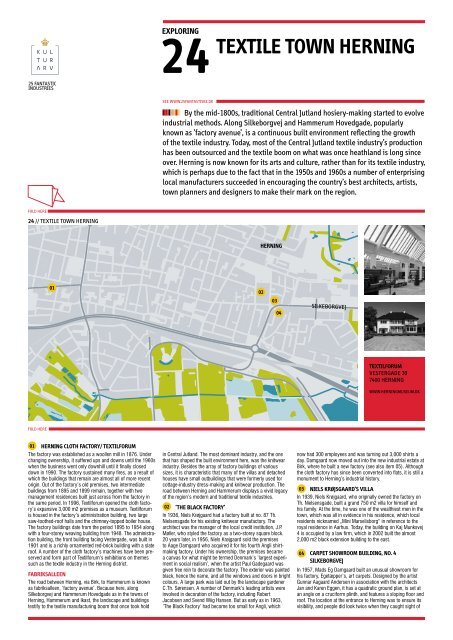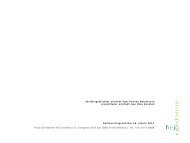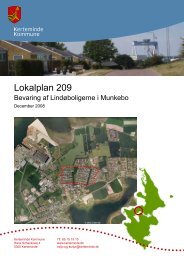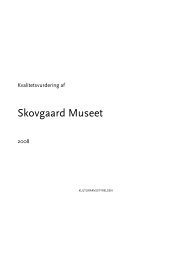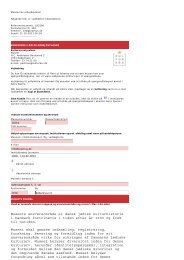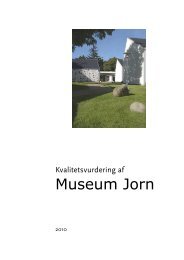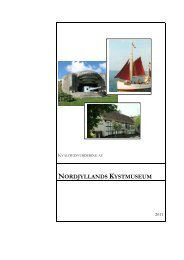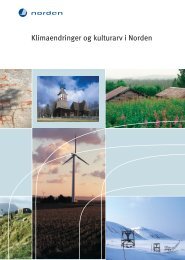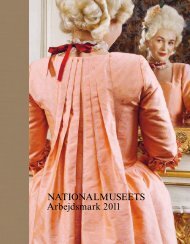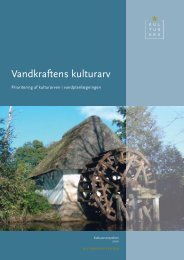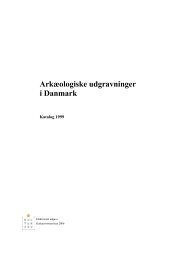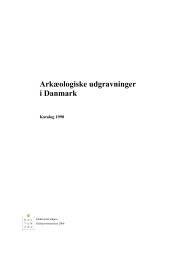TEXTILE TOWN HERNING
TEXTILE TOWN HERNING
TEXTILE TOWN HERNING
Create successful ePaper yourself
Turn your PDF publications into a flip-book with our unique Google optimized e-Paper software.
exploring<br />
24<br />
Textile town Herning<br />
25 fantastic<br />
industries<br />
SEe WWW.25FANTASTISKE.DK<br />
By the mid-1800s, traditional Central Jutland hosiery-making started to evolve<br />
industrial methods. Along Silkeborgvej and Hammerum Hovedgade, popularly<br />
known as ’factory avenue’, is a continuous built environment reflecting the growth<br />
of the textile industry. Today, most of the Central Jutland textile industry’s production<br />
has been outsourced and the textile boom on what was once heathland is long since<br />
over. Herning is now known for its arts and culture, rather than for its textile industry,<br />
which is perhaps due to the fact that in the 1950s and 1960s a number of enterprising<br />
local manufacturers succeeded in encouraging the country’s best architects, artists,<br />
town planners and designers to make their mark on the region.<br />
fold here<br />
24 // Textile town Herning<br />
herning<br />
01<br />
02<br />
03<br />
04<br />
silkeborgvej<br />
textilforum<br />
vestergade 20<br />
7400 herning<br />
www.herningmuseum.dk<br />
fold here<br />
01 <strong>HERNING</strong> CLOTH FACTORY/ Textilforum<br />
The factory was established as a woollen mill in 1876. Under<br />
changing ownership, it suffered ups and downs until the 1960s<br />
when the business went only downhill until it finally closed<br />
down in 1990. The factory sustained many fires, as a result of<br />
which the buildings that remain are almost all of more recent<br />
origin. Out of the factory’s old premises, two intermediate<br />
buildings from 1895 and 1899 remain, together with two<br />
management residences built just across from the factory in<br />
the same period. In 1996, Textilforum opened the cloth factory’s<br />
expansive 3,000 m2 premises as a museum. Textilforum<br />
is housed in the factory’s administration building, two large<br />
saw-toothed-roof halls and the chimney-topped boiler house.<br />
The factory buildings date from the period 1895 to 1954 along<br />
with a four-storey weaving building from 1948. The administration<br />
building, the front building facing Vestergade, was built in<br />
1901 and is a richly ornamented red-brick building with a slate<br />
roof. A number of the cloth factory’s machines have been preserved<br />
and form part of Textilforum’s exhibitions on themes<br />
such as the textile industry in the Herning district.<br />
FABRIKSALLEEN<br />
The road between Herning, via Birk, to Hammerum is known<br />
as fabriksalleen, ’factory avenue’. Because here, along<br />
Silkeborgvej and Hammerum Hovedgade as in the towns of<br />
Herning, Hammerum and Ikast, the landscape and buildings<br />
testify to the textile manufacturing boom that once took hold<br />
in Central Jutland. The most dominant industry, and the one<br />
that has shaped the built environment here, was the knitwear<br />
industry. Besides the array of factory buildings of various<br />
sizes, it is characteristic that many of the villas and detached<br />
houses have small outbuildings that were formerly used for<br />
cottage-industry dress-making and knitwear production. The<br />
road between Herning and Hammerum displays a vivid legacy<br />
of the region’s modern and traditional textile industries.<br />
02 ’THE BLACK FACTORY’<br />
In 1936, Niels Krøjgaard had a factory built at no. 87 Th.<br />
Nielsensgade for his existing knitwear manufactory. The<br />
architect was the manager of the local credit institution, J.P.<br />
Møller, who styled the factory as a two-storey square block.<br />
20 years later, in 1956, Niels Krøjgaard sold the premises<br />
to Aage Damgaard who acquired it for his fourth Angli shirtmaking<br />
factory. Under his ownership, the premises became<br />
a canvas for what might be termed Denmark’s ’largest experiment<br />
in social realism’, when the artist Paul Gadegaard was<br />
given free rein to decorate the factory. The exterior was painted<br />
black, hence the name, and all the windows and doors in bright<br />
colours. A large park was laid out by the landscape gardener<br />
C.Th. Sørensen. A number of Denmark’s leading artists were<br />
involved in decoration of the factory, including Robert<br />
Jacobsen and Svend Wiig Hansen. But as early as in 1963,<br />
’The Black Factory’ had become too small for Angli, which<br />
now had 300 employees and was turning out 3,000 shirts a<br />
day. Damgaard now moved out into the new industrial estate at<br />
Birk, where he built a new factory (see also item 05). Although<br />
the cloth factory has since been converted into flats, it is still a<br />
monument to Herning’s industrial history.<br />
03 Niels Krøjsgaard’s villa<br />
In 1939, Niels Krøjgaard, who originally owned the factory on<br />
Th. Nielsensgade, built a grand 750 m2 villa for himself and<br />
his family. At the time, he was one of the wealthiest men in the<br />
town, which was all in evidence in his residence, which local<br />
residents nicknamed „Mini Marselisborg“ in reference to the<br />
royal residence in Aarhus. Today, the building on Kaj Munksvej<br />
4 is occupied by a law firm, which in 2002 built the almost<br />
2,000 m2 black extension building to the east.<br />
04 Carpet showroom building, No. 4<br />
Silkeborgvej<br />
In 1957, Mads Eg Damgaard built an unusual showroom for<br />
his factory, Egetæpper’s, art carpets. Designed by the artist<br />
Gunnar Aagaard Andersen in association with the architects<br />
Jan and Karen Eggen, it has a quadratic ground plan, is set at<br />
an angle on a cruciform plinth, and features a sloping floor and<br />
roof. The location at the entrance to Herning was to ensure its<br />
visibility, and people did look twice when they caught sight of
this unconventional building. In this way, the building fulfilled its<br />
aim: to be an eye-catching and hence effective advertisement<br />
for Egetæpper. The two Damgaard brothers’ association with<br />
modern artists has been a strongly influential factor in the rich<br />
cultural life of modern Herning.<br />
05 Egetæpper (Carpets)<br />
Mads Eg Damgaard, the founder of the Egetæpper carpet<br />
empire, took at giant leap in 1953 when he wound up his textile<br />
production, sacked all 150 employees except 15 and instead<br />
bought machinery for weaving high-quality Axminster carpets.<br />
But his strategy was successful. Initially, Damgaard’s new factory<br />
had 3 Axminster looms but soon after no fewer than 44,<br />
all in uninterrupted, three-shift operation. The early 1960s saw<br />
the advent of the next technological revolution in the carpet<br />
industry: the tufting loom. Egetæpper went from strength to<br />
strength, moving from a small factory by the original showroom<br />
on Silkeborgvej to this vast, 35,000 m2 complex on<br />
Industrivej. The new premises had space for the large tufting<br />
looms and by 1971, production at the new address was in<br />
full swing. This large factory, which surpassed everything<br />
in the Herning region, was designed by the architect Kaj<br />
fold here<br />
Boeck-Hansen, but underwent extensive alteration in 1982<br />
when it was given a new facade and a showroom and reception<br />
building designed by the Aarhus architect C.F. Møller .<br />
In 1984, a showroom and administration building was added,<br />
also designed by Møller. During this period the architect<br />
created a large number of screening frontages around industrial<br />
plants. The frontage at Egetæpper is around 300 metres long<br />
and is intersected by the large showroom and Søren Georg<br />
Jensen sculptures. The showroom interior is decorated with<br />
wall carpets by the artists Pierre Wermaëre and Asger Jorn<br />
and the atrium garden contains Rudolf Tegner’s sculpture<br />
„Leda and the Swan“. The business is still in operation, but is<br />
today known solely as ’Ege’.<br />
06 ’THE ROUND FACTORY’<br />
When Angli, the shirt-maker’s, outgrew ’The Black Factory’,<br />
Aage Damgaard acquired a large property at Birk. Based on<br />
a concept created by C.Th. Sørensen, ’the Round Factory’<br />
was built in 1965, and the architect was C.F. Møller. C.Th.<br />
Sørensen’s original sketch consisted of two off-centre circles<br />
giving onto a circular courtyard. The sculptures and artworks<br />
from the Black Factory were moved to Birk and C. Th.<br />
Sørensen designed the circular sculpture park. Hereford cattle<br />
were purchased to graze on the circular turf in the park, which<br />
subsequently inspired the idea for the next venture, what is<br />
now a chain of restaurants called Hereford Beefstouw, and<br />
RELATED SITES:<br />
Herning Cloth Factory / Textilforum<br />
Vestergade 20<br />
7400 Herning<br />
www.textilforum.dk<br />
Herning museum of art – heart<br />
Birk Centerpark 8<br />
7400 Herning<br />
www.heartmus.dk<br />
birk<br />
05<br />
06<br />
silkeborgvej<br />
07<br />
08<br />
hammerum<br />
fold here<br />
new artists were contracted to decorate the factory, including<br />
Piero Manzoni, famed for his tin can work containing „Artist’s<br />
shit“. In 1968, Carl-Henning Pedersen’s ceramic frieze was<br />
unveiled in the courtyard: „Picture cycle. The book of imagination<br />
about the wheel of life“. But by 1974, the shirt-making<br />
boom had petered out, and Aage Damgaard shut up shop . The<br />
factory was sold to an arts and education foundation, Midtjysk<br />
Skole- og Kulturfond, set up in 1973. The large art collection<br />
was donated to Herning local authority for the purpose of<br />
establishing a museum of art. Part of the Angli factory was<br />
fitted out for a garment design school, while other parts were<br />
used by Herning Museum of Art from its establishment in 1977<br />
until 2009 when the new museum of art in Herning, HEART,<br />
was completed further along Birk Centerpark at no. 8.<br />
07 Niels Larsen knitwear factory<br />
In 1872, the wool shop keeper Niels Larsen purchased a<br />
rotary power framework machine and he and his wife stepped<br />
up their production of woollen garments. Their business was<br />
soon ready for expansion. In 1883, Larsen acquired the<br />
Hammerumholm estate, where the manufactory gradually<br />
expanded. In 1917, following the death of Niels Larsen, his<br />
widow and son Otto Larsen had the factory building on<br />
Vestergade built. The factory was in operation at this location<br />
until it closed down in 1986. In the late 1990s, Niels Larsen’s<br />
1,500-m2 factory was converted into flats, while the original<br />
factory front facing the road was preserved. Herning Museum<br />
contains a collection of products from the factory including<br />
men’s and women’s underwear, blouses and gym slips.<br />
08 Jensen & Stampe<br />
In the town of Hammerum, Iver Nielsen established a knitwear<br />
factory as early as in 1870, A few years later he moved his<br />
business to what is now no. 95A Hammerum Hovedgade. Not<br />
until later was the factory given the name Jensen & Stampe.<br />
The oldest factory building, two storeys high and facing the<br />
main street, dates from circa 1890. This building is not only<br />
the oldest from this factory, but the oldest textile building in the<br />
district of Hammerum. In 1917-18, a new, larger building was<br />
established at right angles to the main street. This was built<br />
to house a modern knitwear factory, with state-of-the-art<br />
machines. Jensen & Stampe was one of the first businesses<br />
to switch from steam power to electricity in 1906 after<br />
Hammerum gained its own electricity works in 1905. Holger<br />
Jensen, one of the factory’s owners, also happened to be the<br />
electricity works’ chairman. The business did well for many<br />
years, but in 1994, the factory closed down and the premises<br />
were converted into flats. The original exterior of the oldest<br />
building was preserved, however, as a monument to the<br />
district’s oldest knitwear factory.


